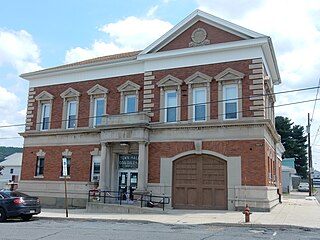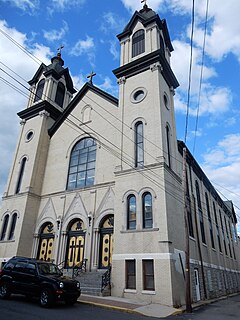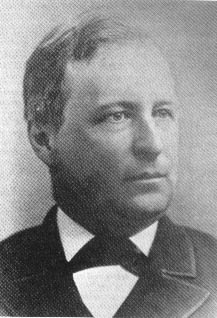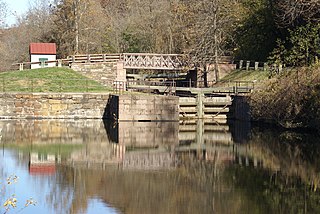Related Research Articles

Schuylkill County is a county in the Commonwealth of Pennsylvania. As of the 2010 census, the population was 148,289. The county seat is Pottsville. The county was created on March 1, 1811, from parts of Berks and Northampton counties and named for the Schuylkill River, which originates in the county. On March 3, 1818 additional territory in its northeast was added from Columbia and Luzerne Counties.

Coaldale is a borough in Schuylkill County, Pennsylvania, United States. Initially settled in 1827, it was incorporated in 1906 from part of the former Rahn Township; it is named for the coal industry—wherein, it was one of the principal early mining centers. Coaldale is in the southern Anthracite Coal region in the Panther Creek Valley a tributary of the Little Schuylkill River, along which U.S. Route 209 was eventually built between the steep climb up Pisgah Mountain from Nesquehoning (easterly) and its outlet in Tamaqua, Pennsylvania about five miles to the west.

Shenandoah is a borough in Schuylkill County, Pennsylvania, United States, located in the anthracite-mining region approximately 120 miles (190 km) west of New York City and 108 miles northwest of Philadelphia. It is distinct from Shenandoah Heights, which is part of West Mahanoy Township immediately to the north.

Tamaqua is a borough in eastern Schuylkill County, Pennsylvania, United States. The borough, located in Central Eastern Pennsylvania's Southern Coal Region, had a population of 7,107 as of the 2010 U.S. Census, a drop of less than 1% from 2000. In 2019, population of 6,691, Tamaqua is part of the Pottsville, PA Micropolitan Statistical Area.

The Schuylkill River is a river running northwest to southeast in eastern Pennsylvania, which was improved by navigations into the Schuylkill Canal. Several of its tributaries drain major parts of the center-southern and easternmost Coal Regions in the state. It flows for 135 miles (217 km) from Pottsville to Philadelphia, where it joins the Delaware River as one of its largest tributaries.

The Coal Region is a historically important coal-mining area in Northeastern Pennsylvania in the central Ridge-and-valley Appalachian Mountains, comprising Lackawanna, Luzerne, Columbia, Carbon, Schuylkill, Northumberland, and the extreme northeast corner of Dauphin counties. Academics have made the distinction between the North Anthracite Coal Field and the South Anthracite Coal Field, the lower region bearing the further classification Anthracite Uplands in physical geology. The Southern Coal Region can be further broken into the Southeastern and Southwestern Coal Regions, with the divide between the Little Schuylkill and easternmost tributary of the Schuylkill River with the additional divide line from the Lehigh watershed extended through Barnesville the determining basins.

The Coal strike of 1902 was a strike by the United Mine Workers of America in the anthracite coalfields of eastern Pennsylvania. Miners striked for higher wages, shorter workdays, and the recognition of their union. The strike threatened to shut down the winter fuel supply to major American cities. At that time, residences were typically heated with anthracite or "hard" coal, which produces higher heat value and less smoke than "soft" or bituminous coal.

Franklin Benjamin Gowen served as president of the Philadelphia and Reading Railroad in the 1870s/80s. He is identified with the undercover infiltration and subsequent court prosecutions of Molly Maguires, mine workers, saloonkeepers and low-level local political figures arraigned and tried for multiple acts of violence, including murders and attempted murders of coal mine operators, foremen and workers, and peace officers.

The Lattimer massacre was the violent deaths of at least 19 unarmed striking immigrant anthracite miners at the Lattimer mine near Hazleton, Pennsylvania, on September 10, 1897. The miners, mostly of Polish, Slovak, Lithuanian and German ethnicity, were shot and killed by a Luzerne County sheriff's posse. Scores more workers were wounded. The massacre was a turning point in the history of the United Mine Workers (UMW).

The Schuylkill Canal, or Schuylkill Navigation, was a system of interconnected canals and slack-water pools along the Schuylkill River in the U.S. state of Pennsylvania, built as a commercial waterway in the early 19th-century. Chartered in 1815, the navigation opened in 1825 to provide transportation and water power. At the time, the river was the least expensive and most efficient method of transporting bulk cargo, and the eastern seaboard cities of the U.S. were experiencing an energy crisis due to deforestation. It fostered the mining of anthracite coal as the major source of industry between Pottsville and eastern markets. Along the tow-paths, mules pulled barges of coal from Port Carbon through the water gaps to Pottsville; locally to the port and markets of Philadelphia; and some then by ship or through additional New Jersey waterways, to New York City markets.

George Frederick Baer was an American lawyer who was the President of the Philadelphia and Reading Railroad and spokesman for the owners during the Anthracite Coal Strike of 1902.
The Coal and Iron Police was a private police force in the US state of Pennsylvania that existed between 1865 and 1931. It was established by the Pennsylvania General Assembly but employed and paid by the various coal companies. The origins of the Coal and Iron Police begin in 1865. Law enforcement in Pennsylvania at that time existed only on the county level or below; an elected sheriff was the primary law enforcement officer. The case was made by the coal and iron operators that they required additional protection of their property. Thus the Pennsylvania State Legislature passed State Act 228. This empowered the railroads to organize private police forces. In 1866, a supplement to the act was passed extending the privilege to "embrace all corporations, firms, or individuals, owning, leasing, or being in possession of any colliery, furnace, or rolling mill within this commonwealth". The 1866 supplement also stipulated that the words "coal and iron police" appear on their badges. A total of over 7,632 commissions were given for the Coal and Iron Police.

The Geology of Pennsylvania consists of six distinct physiographic provinces, three of which are subdivided into different sections. Each province has its own economic advantages and geologic hazards and plays an important role in shaping everyday life in the state. They are: the Atlantic Coastal Plain Province, the Piedmont Province, the New England Province, the Ridge and Valley Province, the Appalachian Plateau Province, and the Central Lowlands Province.

A breaker boy was a coal-mining worker in the United States and United Kingdom whose job was to separate impurities from coal by hand in a coal breaker. Although breaker boys were primarily children, elderly coal miners who could no longer work in the mines because of age, disease, or accident were also sometimes employed as breaker boys. The use of breaker boys began in the mid-1860s. Although public disapproval of the employment of children as breaker boys existed by the mid-1880s, the practice did not end until the 1920s.
The Workingmen's Benevolent Association was a 19th-century labor organization that consisted mainly of coal miners. It was organized in 1868 in Schuylkill County, Pennsylvania, with John Siney as president. In 1869, the organization called a strike of coal-miners from May 5 to June 16. There were some gains resulting from the strike. The union was organized in an area of alleged Molly Maguires activity.

The history of coal mining in the United States goes back to the 1300s, when the Hopi Indians used coal. The first commercial use came in 1701, within the Manakin-Sabot area of Richmond, Virginia. Coal was the dominant power source in the United States in the late 1800s and early 1900s, and although in rapid decline it remains a significant source of energy in 2019.

Pisgah Mountain or Pisgah Ridge is a ridgeline running 12.5 miles (20.1 km) from Tamaqua to Jim Thorpe, Pennsylvania. It is oriented north-northeast to south-southwest, and its north-side valley is followed by U.S. Route 209 from river gap to river gap. The ridge is a succession of peaks exceeding 1,440 feet (438.9 m) rising 300 to 540 feet above the boroughs of Lansford, Coaldale, and Tamaqua in the Panther Creek valley. The highest point on Pisgah Mountain is at 1,611 feet (491 m) in the borough of Summit Hill, which sits atop the ridge. Near Summit Hill was the "Sharpe Mountain" (peak) where in 1791 Phillip Ginter is documented as having discovered anthracite, leading to the formation of the Lehigh Coal Mine Company. In 1818 the Lehigh Coal Company took over the mines, and the mining camp gradually became a settlement and grew into Summit Hill.

Nesquehoning Mountain or Nesquehoning Ridge is a 15–17-mile-long (24–27 km) coal bearing ridge dividing the waters of Lehigh Valley to the north from the Schuylkill River valley and the several near parallel ridgelines of the Ridge-and-valley Appalachians barrier range all local members of which run generally WSW-ENE in the greater overall area.

There are two types of coal found in Pennsylvania: anthracite and bituminous. Anthracite coal is a natural mineral with a high carbon and energy content that gives off light and heat when burned, making it useful as a fuel. It was possibly first used in Pennsylvania as a fuel in 1769, but its real history begins with a documented discovery near Summit Hill and the founding of the Lehigh Coal Mine Company in 1792 to sporadically send expeditions to the wilderness atop Pisgah Ridge to mine the deposits, mostly with notable lack of great success, over the next 22 years. The owners of this company were absentee management—reliant on teams of workers sent under a foreman to fell timber to build so called 'Arks', then mine coal around nine miles from the right bank Lehigh, then trek with mule loads to fill the boats for the trip down the rapid strewn Lehigh River, and then more than 60 miles (97 km) to Philadelphia docks on the unimproved often log choked Delaware River.

Broad Mountain or Broad Ridge in the Ridge-and-Valley Appalachians in Carbon County and Schuylkill County in Eastern Pennsylvania is a steep-faced, anthracite-bearing barrier ridge just south of both Beaver Meadows and Weatherly, north of Nesquehoning and west & south of the Lehigh River basin. The Mountain ridge line is mostly flat and looks very similar to the man made piles of culm in the region from the roads and towns looking up; being a natural mountain, it is quite different when under one's feet.
References
- 1 2 3 Levine JR, Eggleston JR (1992). "U.S. Geological Survey Open-File Report # 92-568 Field Trip Guidebook: The Anthracite Basins of Eastern Pennsylvania" (PDF).
- ↑ Grossman, Johnathan. "The Coal Strike of 1902: Turning Point in U.S. Policy | U.S. Department of Labor". www.dol.gov. US Department of Labor.
| This Pennsylvania state location article is a stub. You can help Wikipedia by expanding it. |
This article has not been added to any content categories . Please help out by adding categories to it so that it can be listed with similar articles, in addition to a stub category. (January 2021) |